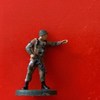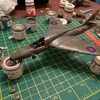-
Content count
648 -
Joined
-
Last visited
Albums posted by Pepelev
-
1/72 Su-7IG "What if"
Updated
- 31 images
- 0 comments
- 0 image comments
My build log for Su-7IG "93 blue"
Brief history
When the PRC declared war on the USSR in 1968 the Soviet Union struggled to launch its Su-7 fitters from long runways, which had been cratered by Chinese air attacks in the opening days. This led the VVS to request a short takeoff and landing strike fighter be placed in production as soon as possible. Having flown in 1967 the Su-7IG was already In a suitable position for production.
Entering production in January 1969 the Su-7IG “Fitter B” took fuselages from Su-7BMKs and mounted them onto the new variable sweep wings. The Su-7IG had four pylons, two under the fuselage and two Under each wing fence allowing the IG to carry 2,200ibs of stores, they also had two NR-30, 30mm cannon with 80 rounds per gun.
Batches of fitter Bs arrived in the Vladivostok area in March 1969. Flying out of Vozdvizhenka the Fitter Bs began to fly tactical strike missions against Chinese Forces. However the lack of pylons became an issue, the Fitters only able to carry weapons on two pylons if external tanks are carried.
By 1970 three regiments of the VVS where flying the Su-7IG. The Fitter Bs very quickly began to revive camouflage in order to help them with their new role, low level surgical strike. Flying under Chinese radar the Fitter-Bs would strike Chinese rear areas such as troop assembly areas, airfields and fuel dumps, armed usually with 500 pound bombs or UB-32 rocket pods they successfully rained havoc behind the PRC lines.
1971,the Fitter Bs began to operate under a whole range of missions, Close air support being their main mission, tactical Strike and low level recon. For recon missions a KKR-1 camera pod would be Carried on the centre line this Fitter B became the Su-7IG/R and every 11th IG built was an IG/R variant. By the early part of 1972 the more modern and capable Su-17 series was available in sufficient numbers to take over most of the work being done by Su-7IGs.
1973 saw the Su-7IGs being passed over to units based in Kazakhstan and Turkmenistan, here after unit work ups they began sorties against eastern China, here the IG saw combat against china’s mig-23 copy the Nanchang Q-6 attack fighter bomber. In air to air combat the IG scored well, achieving a 2:1 ratio in air combat, however the lack of pylons meant all IG air to air missions where completed using guns only.
In March 1974 with the soviet Chinese war dying down the IGs also began to wind down operations. The last mission, a recon sortie being flown on April 6th 1974. Post war the IGs where withdrawn and passed over to soviet training academies, others went on to export, the Su-7IG/K being the export designation, some ended up in Mongolian, Polish, Czech and East German service all being withdrawn from Warsaw Pact airforces in the mid eighties.
-
1/72nd and 1/48th Su-7 and Su-17 kits
Updated
- 1 image
- 0 comments
- 0 image comments
Photos of my model Fitter collection
-
Hawker Fury I
Updated
- 16 images
- 0 comments
- 0 image comments
While testing of the Tempest prototypes was still underway in 1942, the Hawker design team began to study ways to improve and lighten the fighter aircraft. Some of their ideas were influenced by the study of a German Focke-Wulf Fw 190 A-3 that had inadvertently landed in Britain in June 1942. The Fw 190 proved smaller and lighter that its Hawker-built contemporaries. In September 1942, the British Air Ministry issued Specification F.6/42 calling for a new fighter aircraft. Hawker proposed three versions of its improved Tempest, each to be powered by a different engine: the V-12 Rolls-Royce Griffon, the 18-cylinder Bristol Centaurus radial, and the H-24 Napier Sabre.
The Air Ministry supported Hawker’s designs under Specification F.2/43 issued in February 1943. In April 1943, Specification N.7/43 was issued for a new Navy fighter. Sydney Camm, Hawker’s chief designer, felt that arresting gear and folding wings could be added to the “improved Tempest” design to make it meet the requirements laid out in N.7/43. This plan was approved, and Specification N.22/43 was issued to Hawker for the new Navy fighter. Around this time, the two new Hawker aircraft received their official names: Fury (for the Royal Air Force’s land-based version) and Sea Fury (for the Fleet Air Arm’s naval version).
From the beginning, the preferred power plants were the Napier Sabre for the Fury and the Bristol Centaurs for the Sea Fury. Although the detailed design drawings for the Sabre-powered Fury were finished first, developmental delays of the new Sabre VII (NS.93/SM) engine resulted in the Centaurus- and Griffon-powered Furys being completed first. The Centaurus-powered Fury (NX798) first flew on 1 September 1944 followed by the Griffon-powered Fury (LA610) on 27 November 1944. Although the Air Ministry ordered 200 Sabre-powered Fury I aircraft in August 1944, there were rumors that Sabre production would be shut down following the war’s end. In October 1944, the Ministry of Aircraft Production (MAP) assured Hawker that Sabre production would continue. In November 1944, the MAP requested a Sabre-powered Fury prototype be built utilizing the Griffon-powered LA610 airframe. However, in February 1945 the Fury I order was reduced by 50 aircraft to 150. But in March 1945, two additional Sabre-powered prototypes (VP207 and VP213) were requested. Work to install a Sabre engine in LA610 began in July 1945. With the war over and the future of fighting aircraft pointing toward jet power, orders for the Fury I were reduced again in September 1945 to 120 units.
In December 1945, the Air Ministry had informed Hawker that ground attack would be the Fury I’s primary role. Hawker felt the aircraft was not suited for this because of its liquid-cooled engine, and it did not have the armour needed for a ground attacker. As a result, in February 1946, the number of Furys on order was further reduced to 60—and even those were in jeopardy. During this time, modifications of the LA610 airframe had been completed, but the Sabre VII engine was not ready.
Rather than wait for the engine, a Sabre VA (2,600 hp / 1,939 kW) was substituted. Soon, a Sabre VII was installed, and Fury LA610 was flown for the first time with its intended power plant on 3 April 1946. While the rest of the aircraft remained the same as the other prototypes, the power section of LA610 was completely different. A streamlined cowling was installed to cover the liquid-cooled Sabre engine. Coolant radiators were installed in the inboard wing sections, replacing additional fuel tanks. Cooling air would enter the wing’s leading edge, pass through the radiators, and exit via shutters under the wing. This configuration was similar to that used on the sole Tempest I prototype (HM599)—production did not occur because the Air Ministry perceived the wing radiators as too vulnerable to combat damage. The radiator shutters of the Fury I were automatically controlled based on engine temperature. A split duct under the spinner supplied intake air to the engine via the duct’s upper section. Air from the lower duct was directed through engine oil coolers and then out the bottom of the cowling. Not only was it one of the most beautiful aircraft ever built, the Sabre-powered Fury proved to be the highest performance piston-engine aircraft built by Hawker. The 24-cylinder Napier Sabre engine was a horizontal H layout with two crankshafts. The engine had a 5.0 in (127 mm) bore, 4.75 in (121 mm) stroke, and displaced 2,238 cu in (36.7 L). The Sabre VII utilized water/methanol injection to boost power and was capable of 3,055 hp (2,278 kW). To transfer this power to thrust, the Fury I used a 13 ft 3 in (4.0 m) four-blade Rotol propeller. A five-blade propeller like the Sea Fury’s 12 ft 9 in (3.9 m) Rotol unit was considered, but the decreased weight of the four-blade unit proved decisive in its adoption.
The Sabre-powered Fury had a top speed of 483 mph (777 km/h) at 18,500 ft (5,639 m) and 422 mph (679 km/h) at sea level. In contrast, the 2,560 hp (1,909 kw) Centaurus-powered Sea Fury had a top speed 460 mph (740 km/h) at 18,000 ft (5,487 m) and 380 mph (612 km/h) at sea level. The Sabre Fury’s initial rate of climb was 5,480 ft/min (27.8 m/s), and it could reach 20,000 ft (6,096 m) in 4.1 minutes. By comparison, The Sea Fury’s initial rate of climb was 4,320 ft/min (21.9 m/s), and it took 5.7 minutes to reach 20,000 ft (6,096 m). The Fury I’s service ceiling was 41,500 ft (12,649 m). All Fury and Sea Fury aircraft had the same 38 ft 5 in (11.7 m) wingspan. At 34 ft 8 in (10.6 m), the Sabre-powered Fury was 1 in (25.4 mm) longer than the Sea Fury. The Fury I had an empty weight of 9,350 lb (4,241 kg) and a loaded weight of 12,120 lb (5,498 kg).




